Abstract
Polyadenylylated mRNA was purified from poly(I).poly(C)- and cycloheximide-superinduced human fibroblast (FS-4) cultures. The mRNA was subjected to electrophoresis through an agarose/CH3HgOH gel, and human fibroblast beta 1 and beta 2 interferon mRNAs were isolated. Each mRNA preparation was phosphorolyzed at 0 degrees C for 20 min by using a molar excess of polynucleotide phosphorylase to produce RNAs lacking poly(A) and then incubated at 37 degrees C for varying lengths of time to allow the phosphorylase to further digest the deadenylylated RNA from the 3' end in a processive and synchronous manner. Removal of the poly(A) (less than or equal to 100 residues) and approximately 100 adjacent residues from human fibroblast beta 1 interferon mRNA (native length, 900 residues, including a 3'-noncoding region of 203 residues) did not alter the translational activity or the functional stability of this mRNA in Xenopus oocytes, whereas deletion of the poly(A) and approximately 200 adjacent residues decreased its translational efficiency. On the other hand, removal of the poly(A) (approximately 200 residues) and approximately 200 adjacent residues from human fibroblast beta 2 interferon mRNA (native length, 1300 residues) did not alter the translational activity or the functional stability of this molecule in oocytes. Thus, neither the poly(A) nor large segments of the 3'-noncoding region (which includes the hexanucleotide A-A-U-A-A-A sequence, at least in the case of beta 1 mRNA) are required for the maintenance of the functional stability of human beta 1 and beta 2 interferon mRNAs in Xenopus oocytes.
Full text
PDF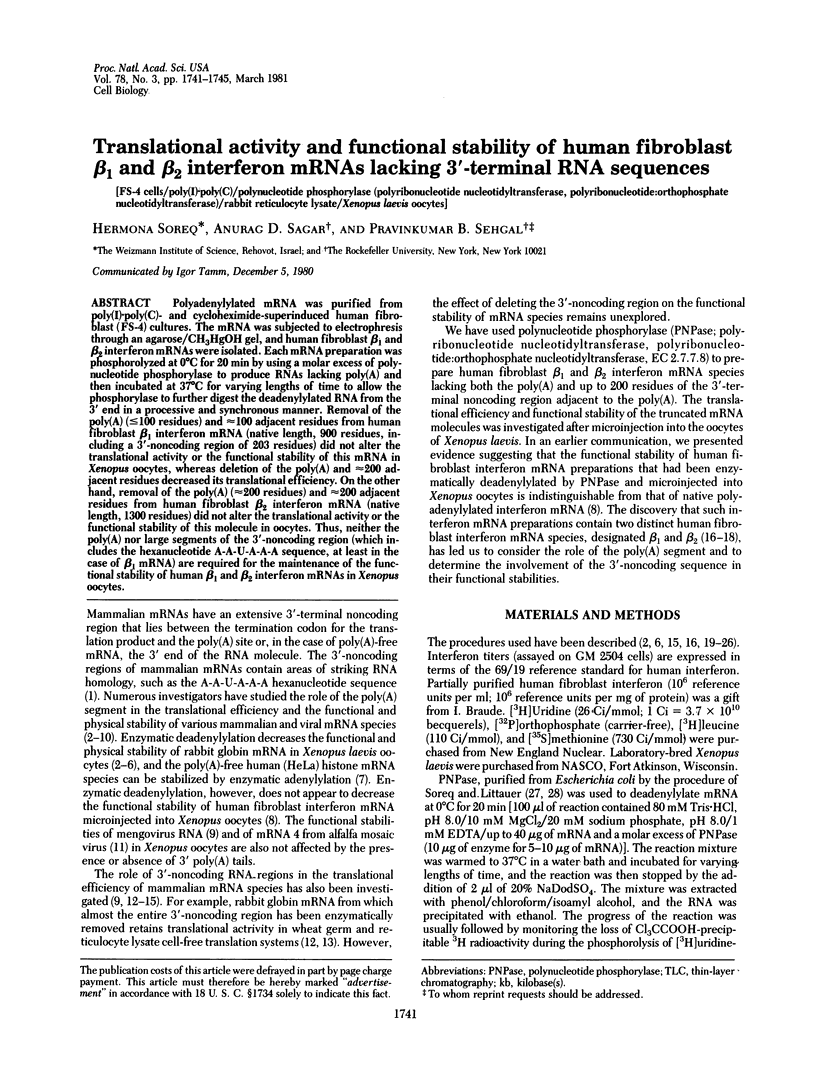
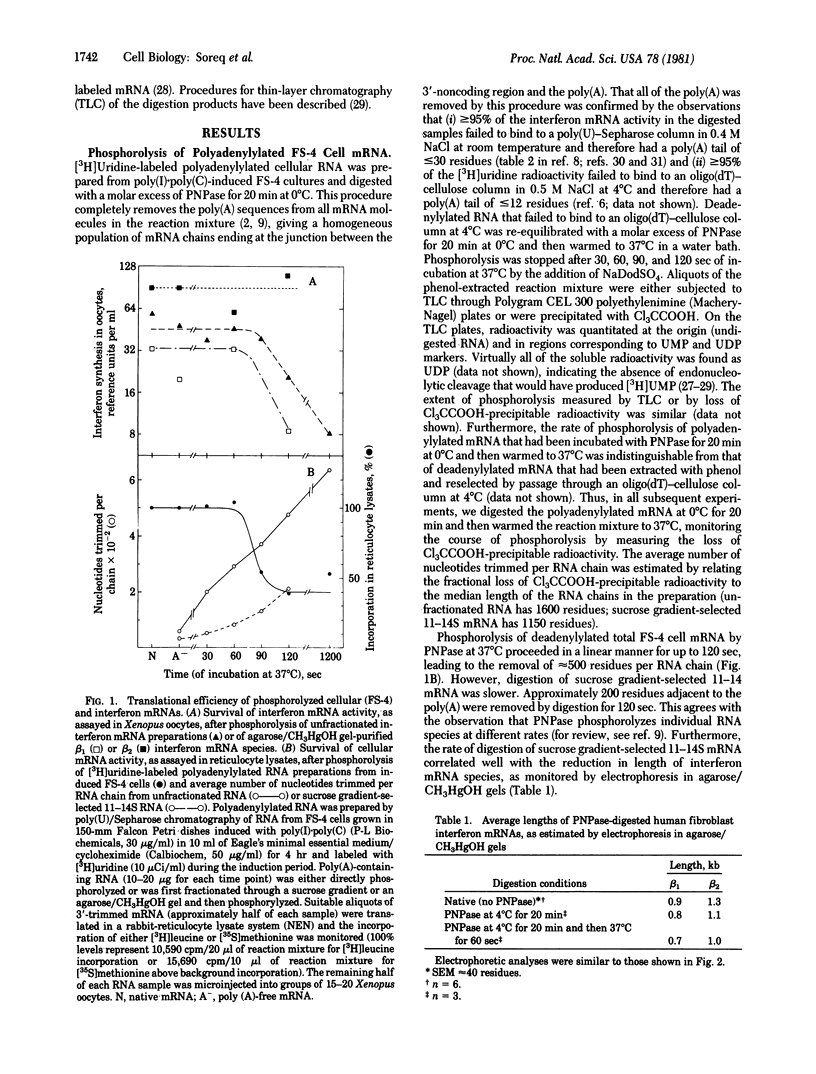
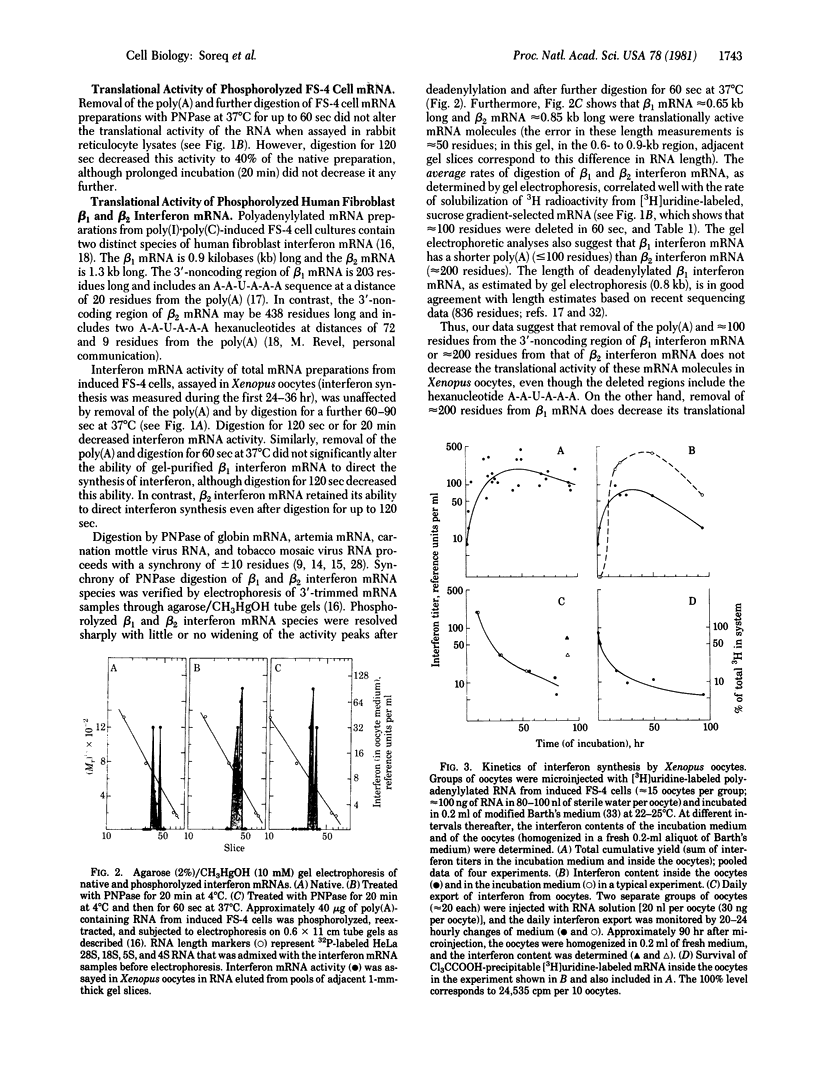
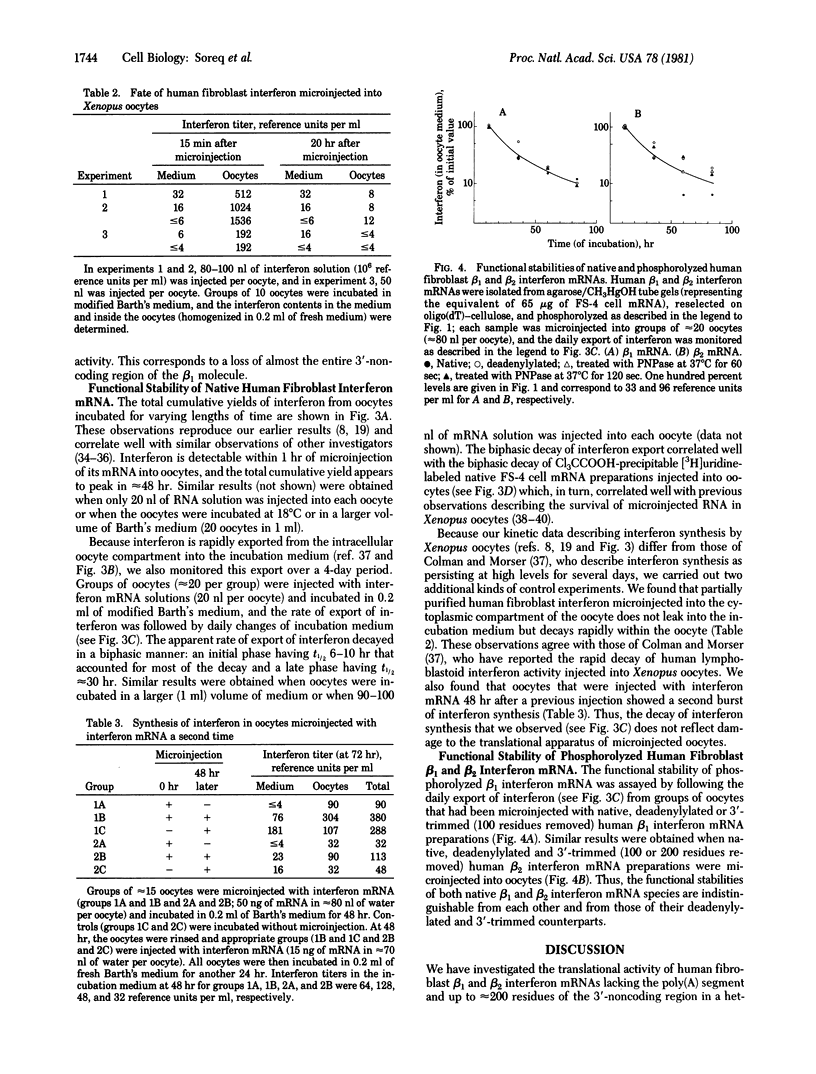
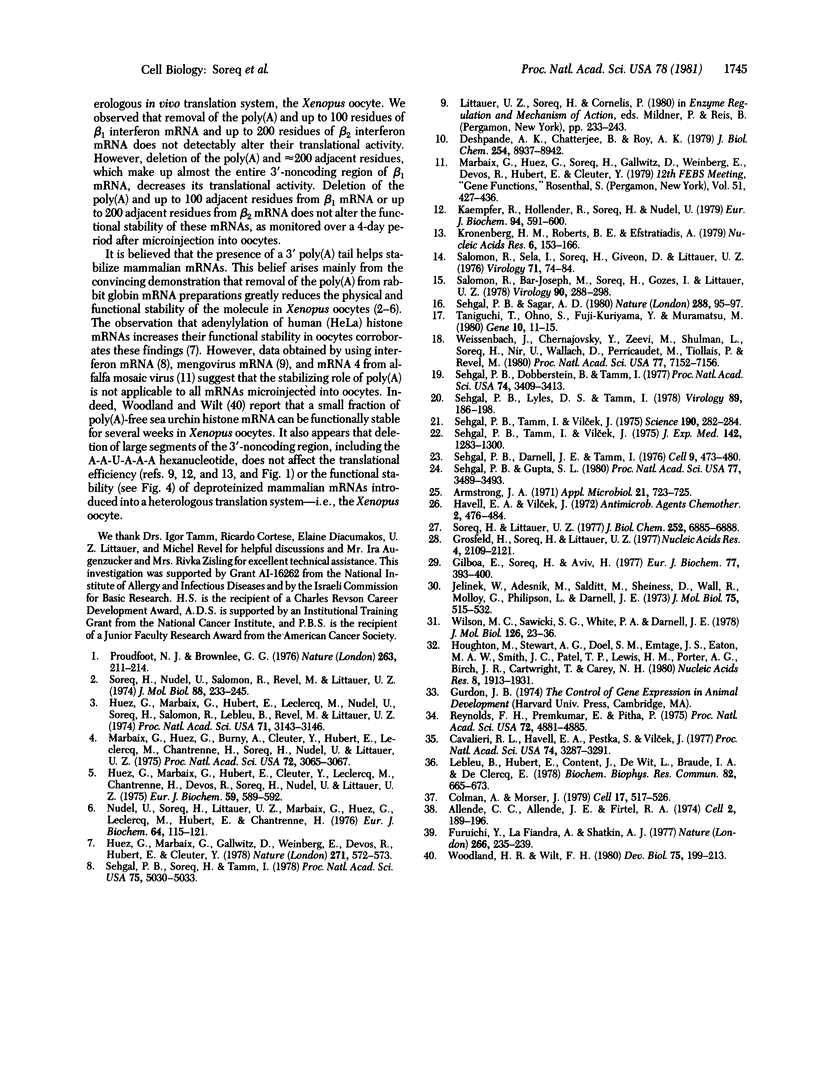
Images in this article
Selected References
These references are in PubMed. This may not be the complete list of references from this article.
- Allende C. C., Allende J. E., Firtel R. A. The degradation of ribonucleic acids injected into Xenopus laevis oocytes. Cell. 1974 Jul;2(3):189–196. doi: 10.1016/0092-8674(74)90093-2. [DOI] [PubMed] [Google Scholar]
- Armstrong J. A. Semi-micro, dye-binding assay for rabbit interferon. Appl Microbiol. 1971 Apr;21(4):723–725. doi: 10.1128/am.21.4.723-725.1971. [DOI] [PMC free article] [PubMed] [Google Scholar]
- Cavalieri R. L., Havell E. A., Vilcek J., Pestka S. Synthesis of human interferon by Xenopus laevis oocytes: two structural genes for interferons in human cells. Proc Natl Acad Sci U S A. 1977 Aug;74(8):3287–3291. doi: 10.1073/pnas.74.8.3287. [DOI] [PMC free article] [PubMed] [Google Scholar]
- Colman A., Morser J. Export of proteins from oocytes of Xenopus laevis. Cell. 1979 Jul;17(3):517–526. doi: 10.1016/0092-8674(79)90260-5. [DOI] [PubMed] [Google Scholar]
- Deshpande A. K., Chatterjee B., Roy A. K. Translation and stability of rat liver messenger RNA for alpha 2 mu-globulin in Xenopus oocyte. The role of terminal poly(A). J Biol Chem. 1979 Sep 25;254(18):8937–8942. [PubMed] [Google Scholar]
- Furuichi Y., LaFiandra A., Shatkin A. J. 5'-Terminal structure and mRNA stability. Nature. 1977 Mar 17;266(5599):235–239. doi: 10.1038/266235a0. [DOI] [PubMed] [Google Scholar]
- Gilboa E., Soreq H., Aviv H. Initiation of RNA synthesis in isolated nuclei. Eur J Biochem. 1977 Jul 15;77(2):393–400. doi: 10.1111/j.1432-1033.1977.tb11679.x. [DOI] [PubMed] [Google Scholar]
- Grosfeld H., Soreq H., Littauer U. Z. Membrane associated cytoplasmic mRNA in Artemia salina; functional and physical changes during development. Nucleic Acids Res. 1977 Jul;4(7):2109–2121. doi: 10.1093/nar/4.7.2109. [DOI] [PMC free article] [PubMed] [Google Scholar]
- Havell E. A., Vilcek J. Production of high-titered interferon in cultures of human diploid cells. Antimicrob Agents Chemother. 1972 Dec;2(6):476–484. doi: 10.1128/aac.2.6.476. [DOI] [PMC free article] [PubMed] [Google Scholar]
- Houghton M., Stewart A. G., Doel S. M., Emtage J. S., Eaton M. A., Smith J. C., Patel T. P., Lewis H. M., Porter A. G., Birch J. R. The amino-terminal sequence of human fibroblast interferon as deduced from reverse transcripts obtained using synthetic oligonucleotide primers. Nucleic Acids Res. 1980 May 10;8(9):1913–1931. doi: 10.1093/nar/8.9.1913. [DOI] [PMC free article] [PubMed] [Google Scholar]
- Huez G., Marbaix G., Gallwitz D., Weinberg E., Devos R., Hubert E., Cleuter Y. Functional stabilisation of HeLa cell histone messenger RNAs injected into Xenopus oocytes by 3'-OH polyadenylation. Nature. 1978 Feb 9;271(5645):572–573. doi: 10.1038/271572a0. [DOI] [PubMed] [Google Scholar]
- Huez G., Marbaix G., Hubert E., Cleuter Y., Leclercq M., Chantrenne H., Devos R., Soreq H., Nudel U., Littauer U. Z. Readenylation of polyadenylate-free globin messenger RNA restores its stability in vivo. Eur J Biochem. 1975 Nov 15;59(2):589–592. doi: 10.1111/j.1432-1033.1975.tb02486.x. [DOI] [PubMed] [Google Scholar]
- Huez G., Marbaix G., Hubert E., Leclercq M., Nudel U., Soreq H., Salomon R., Lebleu B., Revel M., Littauer U. Z. Role of the polyadenylate segment in the translation of globin messenger RNA in Xenopus oocytes. Proc Natl Acad Sci U S A. 1974 Aug;71(8):3143–3146. doi: 10.1073/pnas.71.8.3143. [DOI] [PMC free article] [PubMed] [Google Scholar]
- Jelinek W., Adesnik M., Salditt M., Sheiness D., Wall R., Molloy G., Philipson L., Darnell J. E. Further evidence on the nuclear origin and transfer to the cytoplasm of polyadenylic acid sequences in mammalian cell RNA. J Mol Biol. 1973 Apr 15;75(3):515–532. doi: 10.1016/0022-2836(73)90458-0. [DOI] [PubMed] [Google Scholar]
- Kaempfer R., Hollender R., Soreq H., Nudel U. Recognition of messenger RNA in eukaryotic protein synthesis. Equilibrium studies of the interaction between messenger RNA and the initiation factor that binds methionyl-tRNAf. Eur J Biochem. 1979 Mar;94(2):591–600. doi: 10.1111/j.1432-1033.1979.tb12929.x. [DOI] [PubMed] [Google Scholar]
- Kronenberg M. N., Roberts B. E., Efstratiadis A. The 3' noncoding region of beta-globin mRNA is not essential for in vitro translation. Nucleic Acids Res. 1979 Jan;6(1):153–166. doi: 10.1093/nar/6.1.153. [DOI] [PMC free article] [PubMed] [Google Scholar]
- Lebleu B., Hubert E., Content J., De Wit L., Braude I. A., De Clercq E. Translation of mouse interferon mRNA in Xenopus laevis oocytes and in rabbit reticulocyte lysates. Biochem Biophys Res Commun. 1978 May 30;82(2):665–673. doi: 10.1016/0006-291x(78)90926-9. [DOI] [PubMed] [Google Scholar]
- Marbaix G., Huez G., Burny A., Cleuter Y., Hubert E., Leclercq M., Chantrenne H., Soreq H., Nudel U., Littauer U. Z. Absence of polyadenylate segment in globin messenger RNA accelerates its degradation in Xenopus oocytes. Proc Natl Acad Sci U S A. 1975 Aug;72(8):3065–3067. doi: 10.1073/pnas.72.8.3065. [DOI] [PMC free article] [PubMed] [Google Scholar]
- Nudel U., Soreq H., Littauer U. Z. Globin mRNA species containing poly(A) segments of different lengths. Their functional stability in Xenopus oocytes. Eur J Biochem. 1976 Apr 15;64(1):115–121. doi: 10.1111/j.1432-1033.1976.tb10279.x. [DOI] [PubMed] [Google Scholar]
- Proudfoot N. J., Brownlee G. G. 3' non-coding region sequences in eukaryotic messenger RNA. Nature. 1976 Sep 16;263(5574):211–214. doi: 10.1038/263211a0. [DOI] [PubMed] [Google Scholar]
- Reynolds F. H., Jr, Premkumar E., Pitha P. M. Interferon activity produced by translation of human interferon messenger RNA in cell-free ribosomal systems and in Xenopus oöcytes. Proc Natl Acad Sci U S A. 1975 Dec;72(12):4881–4885. doi: 10.1073/pnas.72.12.4881. [DOI] [PMC free article] [PubMed] [Google Scholar]
- Salomon R., Bar-Joseph M., Soreq H., Gozes I., Littauer U. Z. Translation in vitro of carnation mottle virus RNA. Regulatory function of the 3'-region. Virology. 1978 Oct 15;90(2):288–298. doi: 10.1016/0042-6822(78)90313-6. [DOI] [PubMed] [Google Scholar]
- Salomon R., Sela I., Soreq H., Giveon D., Littauer U. Z. Enzymatic acylation of histidine to tobacco mosaic virus RNA. Virology. 1976 May;71(1):74–84. doi: 10.1016/0042-6822(76)90095-7. [DOI] [PubMed] [Google Scholar]
- Sehgal P. B., Darnell J. E., Jr, Tamm I. The inhibition by DRB (5,6-dichloro-1-beta-D-ribofuranosylbenzimidazole) of hnRNA and mRNA production in HeLa cells. Cell. 1976 Nov;9(3):473–480. doi: 10.1016/0092-8674(76)90092-1. [DOI] [PubMed] [Google Scholar]
- Sehgal P. B., Dobberstein B., Tamm I. Interferon messenger RNA content of human fibroblasts during induction, shutoff, and superinduction of interferon production. Proc Natl Acad Sci U S A. 1977 Aug;74(8):3409–3413. doi: 10.1073/pnas.74.8.3409. [DOI] [PMC free article] [PubMed] [Google Scholar]
- Sehgal P. B., Gupta S. L. Regulation of the stability of poly(I)xpoly(C)-induced human fibroblast interferon mRNA: selective inactivation of interferon mRNA and lack of involvement of 2',5'-oligo(A) synthetase activation during the shutoff of interferon production. Proc Natl Acad Sci U S A. 1980 Jun;77(6):3489–3493. doi: 10.1073/pnas.77.6.3489. [DOI] [PMC free article] [PubMed] [Google Scholar]
- Sehgal P. B., Lyles D. S., Tamm I. Superinduction of human fibroblast interferon production: further evidence for increased stability of interferon mRNA. Virology. 1978 Aug;89(1):186–198. doi: 10.1016/0042-6822(78)90051-x. [DOI] [PubMed] [Google Scholar]
- Sehgal P. B., Sagar A. D. Heterogeneity of poly(I) x poly(C)-induced human fibroblast interferon mRNA species. Nature. 1980 Nov 6;288(5786):95–97. doi: 10.1038/288095a0. [DOI] [PubMed] [Google Scholar]
- Sehgal P. B., Soreq H., Tamm I. Does 3'-terminal poly(A) stabilize human fibroblast interferon mRNA in oocytes of Xenopus laevis? Proc Natl Acad Sci U S A. 1978 Oct;75(10):5030–5033. doi: 10.1073/pnas.75.10.5030. [DOI] [PMC free article] [PubMed] [Google Scholar]
- Sehgal P. B., Tamm I., Vilcek J. Enhancement of human interferon production by neutral red and chloroquine: analysis of inhibition of protein degradation and macromolecular synthesis. J Exp Med. 1975 Nov 1;142(5):1283–1300. doi: 10.1084/jem.142.5.1283. [DOI] [PMC free article] [PubMed] [Google Scholar]
- Sehgal P. B., Tamm I., Vilcek J. Human interferon production: superinduction by 5,6-dichloro-1-beta-D-ribofuranosylbenzimidazole. Science. 1975 Oct 17;190(4211):282–284. doi: 10.1126/science.1179208. [DOI] [PubMed] [Google Scholar]
- Soreq H., Littauer U. Z. Purification and characterization of polynucleotide phosphorylase from Escherichia coli. Probe for the analysis of 3' sequences of RNA. J Biol Chem. 1977 Oct 10;252(19):6885–6888. [PubMed] [Google Scholar]
- Soreq H., Nudel U., Salomon R., Revel M., Littauer U. Z. In vitro translation of polyadenylic acid-free rabbit globin messenger RNA. J Mol Biol. 1974 Sep 5;88(1):233–245. doi: 10.1016/0022-2836(74)90307-6. [DOI] [PubMed] [Google Scholar]
- Taniguchi T., Ohno S., Fujii-Kuriyama Y., Muramatsu M. The nucleotide sequence of human fibroblast interferon cDNA. Gene. 1980 Jun;10(1):11–15. doi: 10.1016/0378-1119(80)90138-9. [DOI] [PubMed] [Google Scholar]
- Weissenbach J., Chernajovsky Y., Zeevi M., Shulman L., Soreq H., Nir U., Wallach D., Perricaudet M., Tiollais P., Revel M. Two interferon mRNAs in human fibroblasts: in vitro translation and Escherichia coli cloning studies. Proc Natl Acad Sci U S A. 1980 Dec;77(12):7152–7156. doi: 10.1073/pnas.77.12.7152. [DOI] [PMC free article] [PubMed] [Google Scholar]
- Wilson M. C., Sawicki S. G., White P. A., Darnell J. E., Jr A correlation between the rate of poly(A) shortening and half-life of messenger RNA in adenovirus transformed cells. J Mol Biol. 1978 Nov 25;126(1):23–36. doi: 10.1016/0022-2836(78)90277-2. [DOI] [PubMed] [Google Scholar]
- Woodland H. R., Wilt F. H. The functional stability of sea urchin histone mRNA injected into oocytes of Xenopus laevis. Dev Biol. 1980 Mar;75(1):199–213. doi: 10.1016/0012-1606(80)90155-4. [DOI] [PubMed] [Google Scholar]



